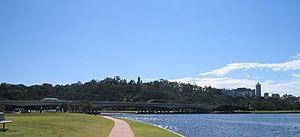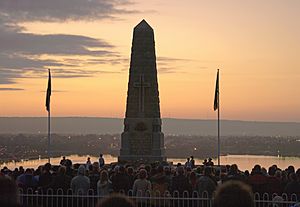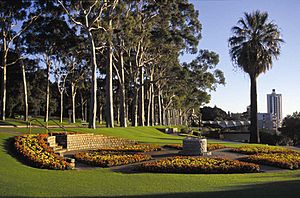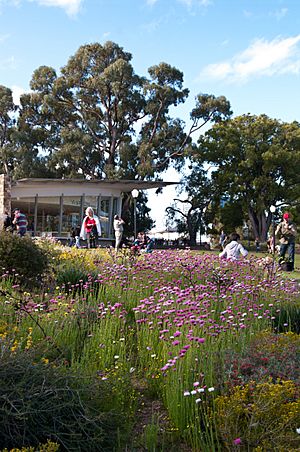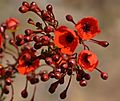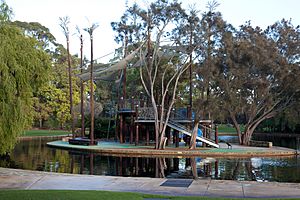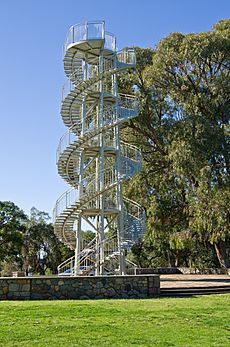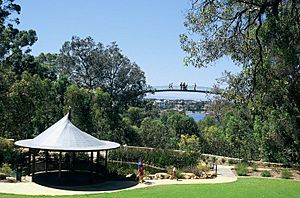Kings Park, Western Australia facts for kids
Quick facts for kids Kings Park |
|
|---|---|

Eternal flame, with State War Memorial (behind)
|
|
| Location | Perth, Western Australia |
| Area | 400.6 ha (990 acres) |
| Designated | 1831 |
| Founder | James Stirling and John Septimus Roe |
| Owned by | Crown (public) |
| Administered by | Botanic Gardens and Parks Authority (BGPA) |
| Visitors | 5.8 million (in 2012) |
| Open | Always |
| Status | Open |
| Designation | A-Class Reserve |
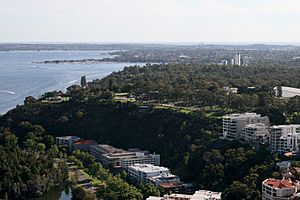
Kings Park is a huge park in Perth, Western Australia. It covers about 400.6-hectare (990-acre) of land. From the park, you can see amazing views of Perth Water and the city's main area.
This special park has grassy areas, beautiful botanical gardens, and natural bushland. About two-thirds of the park is kept as native bush. It sits on a hill called Mount Eliza. You can see the Swan River and the Darling Range from here.
Kings Park is home to over 324 types of native plants. It also has 215 kinds of fungi and 80 bird species. It is the most popular place to visit in Western Australia. More than five million people come here every year!
Besides places for tourists, Kings Park has the State War Memorial. It also has the Royal Kings Park Tennis club and a water reservoir. Many streets in the park are lined with trees. Each tree has a plaque. These plaques honor Western Australian service members who died in World War I and World War II.
The park is also full of animals, both native and those brought from other places. Every September, Kings Park hosts Australia's biggest wildflower show. It's called the Kings Park Festival.
Contents
Discovering Kings Park's Past
Before Europeans arrived, the Aboriginal Noongar people lived here. They called Mount Eliza Mooro Katta and Kaarta Gar-up. This area was a very important cultural and ceremonial place for the Whadjuk tribe. They had campsites and hunting grounds here.
At the bottom of the southern side of the hill is a fresh water spring. It is called Kennedy Spring (Goonininup). This spring gave water all year round to the native people. The first European visitors saw the spring on 11 January 1697.
James Stirling, who was in charge of the Swan River Colony, chose Perth as a townsite because of this spring. He named the area Mount Eliza.
Over time, people realized how special this land was. In 1871, a surveyor named Malcolm Fraser convinced the Governor to protect about 432 acres (175 ha) of land as a public reserve. More land was added later.
Kings Park officially opened on 10 August 1895. It was first called Perth Park. In 1901, it was renamed King's Park. This was to honor King Edward VII when he became king of Britain. It also marked the visit of George, the Duke of Cornwall and Princess Mary to Perth. One of the main roads in the park, May Drive, is named after Princess Mary.
The first tree planted in the park was a Norfolk Island Pine. Other trees were also planted, but many did not grow well because there was not enough water.
Since 1999, the Botanic Gardens and Parks Authority (BGPA) has managed Kings Park. They also look after Bold Park. The park's office helps visitors. You can book guided walks or get information there.
Kings Park has even been on TV! It was featured on the American reality show The Amazing Race 9 in 2006. It also appeared on The Amazing Race Australia 1 in 2011.
In 2009, a fire badly damaged the southwestern part of the park. People thought it was started on purpose.
Views from Kings Park
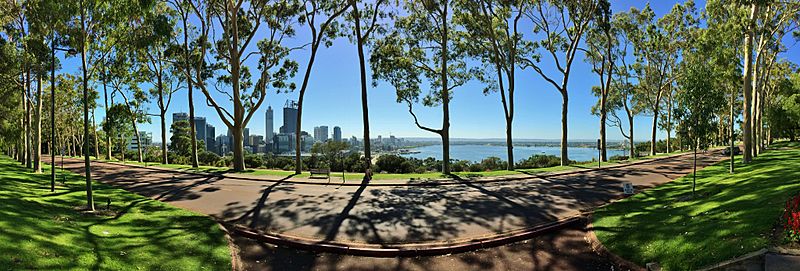
Important Memorials
State War Memorial
The State War Memorial Precinct is on Mount Eliza. It looks out over Perth Water. This area includes the Cenotaph, the Court of Contemplation, the Flame of Remembrance, and the Pool of Reflection.
The Anzac Day dawn service is held here every year on 25 April at 5:30 am. More than 40,000 people attend. There is also a service on 11 November for Remembrance Day at 11 am.
The Cenotaph was first shown to the public on 24 November 1929. The Flame of Remembrance and Pool of Reflection were opened by Queen Elizabeth II on 1 April 2000.
Underneath the Cenotaph is a special list. It has the names of all service members from Western Australia who died in various wars. These include the Second Boer War, World War I, World War II, Korean War, and Vietnam. In 2012, names of those who died in Iraq and Afghanistan were added.
You can find other smaller memorials throughout the park. They honor specific battles, military groups, and prisoners of war.
Honour Avenues
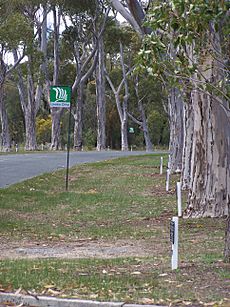
The roads in Kings Park are lined with eucalyptus trees. In front of each tree is a plaque. These plaques honor service members who died in action or from war wounds. There are over 1600 of these plaques.
This idea came from Mr. Arthur Lovekin. Families used to pay a small fee to help cover the cost of planting. Ex-servicemen helped plant the trees. Kings Park now has three tree-lined avenues for honoring service personnel: May Drive, Lovekin Drive, and Marri Walk.
Fraser Avenue
This avenue was first planted with Red-flowering gums in 1898. This was to celebrate Queen Victoria's Jubilee. Later, in 1929, more trees were added for the State Centenary. However, the gums got a disease.
In 1938, Lemon Scented Gum trees were planted instead. These trees now line the avenue. They honor important people who helped with the Western Australia Centenary in 1929.
Bali Memorial
This memorial remembers the 16 people from Western Australia who died in the 2002 Bali bombings. It also honors those who were injured and those who helped survivors. The bombings happened on 12 October 2002 in Kuta, Bali. Many people were killed and injured, including 88 Australians.
Edith Dircksey Cowan Memorial
The Edith Dircksey Cowan Memorial is a clock tower. It is at the main entrance to Kings Park. It was built in 1934 to remember Edith Cowan. She was the first woman elected to an Australian parliament.
Western Australian Botanic Garden
The botanic garden covers 18 hectares (44 acres) within Kings Park. It is called the Western Australian Botanic Garden. It has a collection of 2000 different types of plants from Western Australia. This garden helps protect plants from around the world.
The garden was designed by John Oldham. It was created to show off Western Australia's plants for the 1962 British Empire and Commonwealth Games. It officially opened on 4 October 1965.
Today, the Botanic Garden has over half of Australia's 25000 plant species. Some popular spots in the garden include:
- Conservation Garden
- Gija Jumulu Boab Tree
- Pioneer Women's Memorial Fountain and Water Garden
- Centenary of Western Australian Women's Suffrage Memorial
- Lotterywest Federation Walkway
- Some plants photographed in Kings Park
-
Pileanthus sp.
Plant Science and Conservation
The Botanic Gardens and Parks Authority has a Science team. They are known for their research in plant conservation. They work to protect and restore native plant species and their natural homes. Their work includes studying seeds, plant genetics, and how to grow plants. Many scientists and students work here.
Kings Park Festival: A Wildflower Celebration
The Kings Park Festival started in 1965. It has grown into a month-long event in September. It features amazing flower displays, live music, and workshops. There are also art exhibits, guided walks, and family activities. The festival promotes the beauty of Western Australia's native wildflowers. Over 500,000 people visit, including gardeners, families, and artists.
Fun for Families: Playgrounds and More
May Drive Parkland
The May Drive Parkland is one of two playgrounds in Kings Park. The other is the Ivey Watson Playground. This parkland has a lake, an island, and play equipment for kids. It also has life-sized model dinosaurs!
The Vietnam War memorial and Zamia café are also in this area.
Lotterywest Family Area
This playground is very popular with young families. It is made for children under five years old. It helps encourage early childhood development. It was updated in 2006 with money from Lotterywest.
Aboriginal Art Gallery
The Aboriginal Art Gallery is a shop on Fraser Avenue. It shows and sells art by Aboriginal artists. These artists come from Western Australia and the Northern Territory.
DNA Tower
The DNA Tower was built in 1966. It is on the highest point of the park. This white tower is 15 m (49 ft) tall. It has 101 steps that form a double helix staircase. Its design looks like a deoxyribonucleic acid (DNA) molecule. The path below the tower is made with stones. These stones were sent from 11 towns and 80 areas in Western Australia.
Jacob's Ladder
Jacob's Ladder is a set of stairs near Kings Park. It is not part of the park itself. It has 242 steps and goes down to Mounts Bay Road. Many people in Perth use these stairs to exercise.
The stairs were closed for repairs after a landslide in a storm on 22 March 2010. They reopened on 21 June 2010.
Explore Kings Park: Walking Trails
Law Walk
Law Walk is a top bushland trail in Kings Park. It is a 2.5 km (1.6 mi) loop walk. It starts at Rotunda Two and follows a ridge to Dryandra Lookout. The trail then loops back to the Lotterywest Federation Walkway and the start. It takes about 45 minutes to complete.
The Kokoda Track Memorial Walk
The Kokoda Track Memorial Walk honors the brave Australian soldiers. They fought in Papua New Guinea from July 1942 to January 1943. The walk starts at Kennedy Fountain on Mounts Bay Road. It is a steep climb of 150 steps, going up 62 m (203 ft).
Guided Walks
The Kings Park Guides started in 1984. They are volunteers who lead guided walks all year. They also help at the Visitor Information Centre. Twice a day, they offer tours of the memorials, bushland paths, and Botanic Garden.
The guides share information about all parts of the park. This includes the local Noongar names and traditions. Walks change depending on the Noongar season. For example, there are special walks for the wildflower season (Djilba-Kambarang, July–October).
Helping Hands: Volunteers and Community
The Friends of Kings Park group started in 1993. They encourage people to get involved with Kings Park and the Botanic Garden.
The Kings Park Volunteer Master Gardeners offer free advice to the community. They can help with anything from planting to dealing with pests.
Since 1922, the Honour Avenues Group has looked after the plaques on Kings Park's Honour Avenues. They make sure these important memorials are kept in good condition.
See also
 In Spanish: Kings Park en Australia Occidental para niños
In Spanish: Kings Park en Australia Occidental para niños


